1956
Vincenzo Fasolo, "The Campo Marzio of G. B. Piranesi".
2691a
2691d
1982.03.01
The complex of buildings...

"The complex of buildings in the center of Rossi's cemetery, however, is not found in the 19th century cemeteries of the Modena/Genoa type. That idea came from another source, Giovanii Battista Piranesi's reconstruction of the Campo Marzio in Rome, as he imagined it stood in late imperial times. In Piranesi's map, a large portion of the right bank of the Tiber is occupied by a group of funerary monuments dominated by the mausoleum of Hadrian, which we now know as Castel Sant'Angelo. Hadrian's tomb sits on a square base near the river. Beyond this square is a U-shaped group of buildings marked Sepulchra. They embrace the bottom of a fan-shaped structure designated by the word clitoporticus. At the apex of the fan sits a round building called Basilica. This Basilica is part of a group of monuments labeled Bustum Hadriani, designating the place where cremation occurs. The correspondence in general layout between the Piranesi and Rossi plans is too close to be accidental. Rossi, who knew this Piranesi work perfectly well (a fragment of it appears in Rossi's drawing The Analogous City, 1976), has lifted Piranesi's vision of an Imperial ancient city of the dead within the context of late-antiquity Rome, and placed it in the middle of a 19th-century cemetery plan."
--Eugene J. Johnson, "What Remains of Man--Aldo Rossi's Modena Cemetery" (1982).
| |
1995.01.07
outline - long[est] axis
Moving to the other extreme of the axis, we find a triumphal arch which mirrors the arch at the entrance of the Area Martis. These two arches, both on the long axis, are also disposed with respect to the cross axis of Hadrian's tomb. This begins the analysis of the Hadrian complex.
--Hadrian's tomb being one of the very few extant building within the Ichnographia.
--the discovery and true placement of the circus Hadriani (see Nolli map) and how the tomb and the circus probably spurned the enormity of the entire Hadrian complex and the second longest axis in the Ichnographia. Also included is the continuation of an orthogonal layout and the extreme exercise of symmetry.
--the two porticus Hadriani on both sides of the Tiber.
--the interesting correlation of the long row of sepulchers in the Hardian complex to the three sided sepulchers in the Horti Neroniani.
1997.03.20
Exhibit 1 text
Life and Death within Piranesi's Ichnographia of the Campo Marzio

With a consistent dashed line, Piranesi demarcates the Triumphal Way through the Campo Marzio. The processional route begins, with historical and archeological accuracy, at the Templum Jani, which is situated at the bottom of the Ichnographia. The victor's march weaves through Rome's "theater district"--past small baths, shops, and brothels--and then continues on a long straight course towards the Tiber. Across the river, the procession turns behind the Sepulchrum Hadriani and approaches its end at the Templum Martis, the god of War and for whom the Campo Marzio is named. As the ultimate destination of the Triumphal Way, the Templum Martis is clearly among the most sacred, if not the most sacred, of places within the Campo Marzio, and, therefore, perhaps offers a key that lifts the Campo Marzio's "mask."
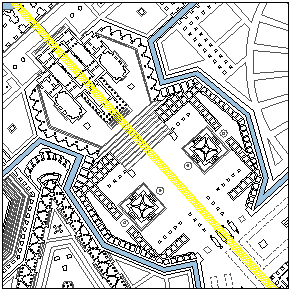
The Templum Martis fittingly promulgates overt manliness. Male genitalia boldly inform the Temple's plan, and the linear projection of the Temple's "endowment" manifests the Campo Marzio's longest straight axis.
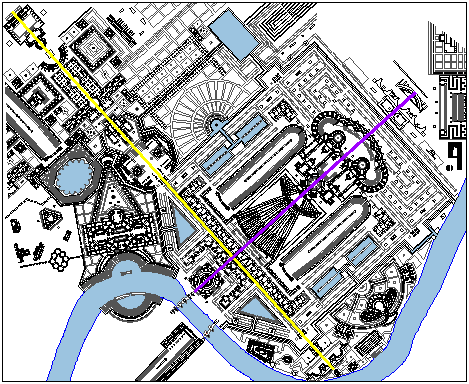
As the axis of Mars spans from the Vatican Hill to the bend in the Tiber, it intersects the Campo Marzio's second longest straight axis, which bisects Hadrian's Tomb and the Bustum Hadriani. The perpendicular crossing of the two axes naturally creates a diametrical opposition. Geometry alone, however, does not represent the depth of their oppositeness.
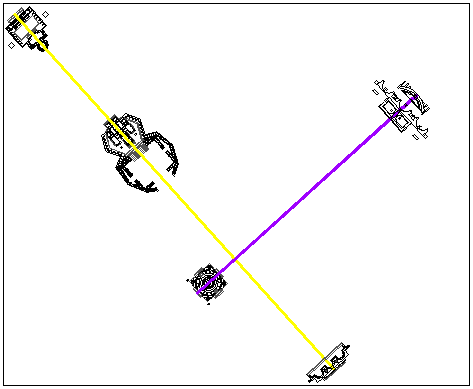
The axis of Mars terminates at either end with a nymphaeum, while the axis through the Bustum Hadriani terminates at either end with an Imperial Tomb. The antithesis of nymphaeums and tombs is self-evident, and, therefore, attests to the axis of Mars representing life and the Bustum axis representing death.
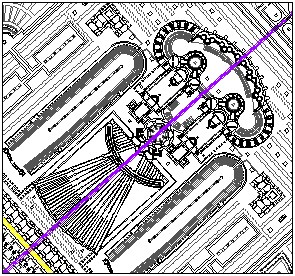
The Bustum Hadriani with its crematoriums and funereal banqueting halls, moreover, is nothing less that a gigantic "machine" to facilitate the passage from this life to the next. Yet, for all its architectural bombast, the Bustum Hadriani can in no way compete with the exalted simplicity of the tiny unnamed structure, which is behind the nymphaeum on the bank of the Tiber and at the very tip of the axis of life.
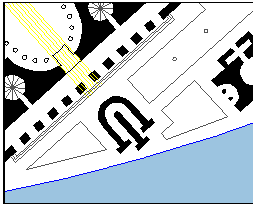
| |
1997.08.05
architectural promenade
...the new ideas re: the architectural promenade that developed because of the Danteum. Essentially, the Danteum has the same sequential series of architectural "events" as the formula for the architectural promenade that I have extracted from Le Corbusier and Stirling. The Danteum, however, adds the element of a journey from the profane to the sacred, and this addition significantly opens up the interpretive field and the buildings that can now be included as exhibiting the architectural promenade formula.
With regard to the profane/scared aspect, the triumphal way within Piranesi's Campo Marzio exhibits the same sequence. The procession (promenade) begins at the Templum Jani, a tetrahedron, which is the forest, the pilotis that raise the box. From there the route jaggedly marches through the "theater district" (downtown)--this is hell, the profane, the lower level. Just as the "way" approaches the Banks of the Tiber for the first time, the procession becomes straight and passes repetitive / monotonous buildings. The way remains perfectly straight except for two 90 degree turns, and this course comprises the greatest length of the promenade. (The straight portion of the procession passes, in sequential order, the Hecatonstylon and the outer niched wall of the Horti prius Pompejani deim Marci Antonii; then the long portico of the Stadium opposite the Domus Alexandri Severi; and across the river between the Porticus Hadriani and the Sepulchrum Libertorum et Servorum of the Bustum Hadriani. These buildings well exemplify the notion of inside/outside, thus tying the triumphal way more closely to the architectural promenade formula.) In the course of this long march, the procession crosses over from the area (of the Campo Marzio) that primarily represents life (inside/outside -- osmosis connection?) into the area that is primarily of death (the Bustum Hadriani). This is the same transition as in the Danteum's Purgatory, and the middle inside/outside level of the Villa Savoye (etc.). Ultimately, the Triumphal way ends at the Templum Martis, easily the most sacred place/space of the Campo Marzio. This culmination to the triumphal procession is analogous to the Paradiso of the Danteum, and to the solarium of the Villa Savoye (etc.). Of course, this has major implications towards my previous analysis of the Triumphal Way.
1997.09.21
The Longest Axis / The Axis of Life
1998.01.07
Points of Departure
I have decided to put together a critical essay regarding my interpretations and disputations of the contemporary existing texts on the Ichnographia. It will be called "Points of Departure"...
...this combined presentation technique may also follow Piranesi's methodology, thus offering the possibility of a further "re-enactment".
In thinking of the typologies... ...regard to Tafuri's comments of the Ichnographia being a sample book and something unknowable. ...the [scale] comparison between St. Peter's and the Bustum Hadriani is a perfect place to start, although I could also compare the Ichnographia plans to other ancient Roman plans, particularly the large baths. Such drawings would refute Tafuri's and Bloomer's statements regarding the smallness (and seemingly insignificantly treated Pantheon and tomb of Hadrian).
...Piranesi's cribbing of the Porticus Aemilia for the Septa Julia may actually represent Piranesi's scale for the entire Ichnographia. It could be that Piranesi very purposefully installed the Forma Urbis fragment of the Porticus Aemilia into the Ichnographia for the precise purpose of demonstrating more of the actual scale (and gigantism) of ancient Rome (--it is as if Piranesi is here illustrating his own quote about how one just has to look around at Rome and Hadrian's Villa to see the examples he emulates.) Piranesi was not being deceptive or misleading, nor was he acting out of ignorance of the fragment's true identity. Piranesi used the Porticus Aemilia as evidence and example.
1998.01.18
in memory of Aldo Rossi
I now see that Rossi's death in September '97 fits precisely into the Redrawing the Ichnographia of Piranesi's Il Campo Marzio dedication. Since September I have discovered the connection between Rossi's Modena Cemetery and Piranesi' Bustum Hadriani. The profusion of coincidences here is almost unbelievable: cemetery, bustum, axis of death, death in September, link to Piranesi...
1998.02.08
Aldo Rossi and the Axis of Death
...a reference to Rossi's own death in September 1997. ...demonstrate the effect of the Bustum Hadriani on Rossi's Modena Cemetery design. ...finding [Rossi's design] on the Axis of Death.
Piranesi and the Ichnographia are never mentioned within The Architecture of the City or The Scientific Autobiography even though the autobiography is all about personal inspirations.
In reading the article in Oppositions 5, (Rafael Moneo, "Aldo Rossi: The Idea of Architecture and the Modena Cememtery") there are some descriptions of Rossi's notions of the city that also describe the Ichnographia:
These elements are intelligible through memory, not through remembering. This kind of extreme analytic suspension gives us a fleeting glimpse of the raison d'Ítre of the city.
But the wish to clarify, to order the elements with which the city is constructed, leads Rossi to present "the fundamental hypothesis of the book . . . the study of a typology of buildings in relation to the city."
However, before proceeding, it is necessary to recall the architectonic category of permanence which Rossi associates with memory. There are, in the city, urban facts which are permanent, that withstand the passage of time; these urban facts are the monuments that, in one way or another, constitute or make up and configure the city. The monument therefore has more than an intelligible and atmospheric value, it is not only architecture as anecdote, as the picturesque, but it gives meaning to the life of the city which, through these monuments, both remembers the past and uses 'its memory.'
This collective nature explains the value of history: "the city is a repository of history."
The city is faithful to its own "memory," a term the Maurice Halbwachs already applied to the city. "The city is the locus of collective memory. Memory this becomes . . . the conducting thread of the entire complex structure . . . the collective nature and the individuality of urban facts arrange themselves into the same urban structure. Within this structure memory becomes the conscience of the city.
1998.04.23
the Ichnographia as "theme park"
...the notion of the Ichnographia being used (perhaps for the first time) as a "guide map." Using the Ichnographia as a guide would seem ridiculous to most because the large plan has always been dismissed as a pure fantasy. It can act as a guide, however, especially if one is aware of the textual background of the plan, meaning the historical texts which describe ancient Rome.
...looking at the Ichnographia as an ancient Roman theme park--a virtual place where one can vicariously experience the ancient city as well as learn about the history of the city.
The themes Piranesi uses are numerous:
a. the Imperial genealogy of both the Bustum Augusti and the Bustum Hadriani.
b. the forward and backward "ride" of the Triumphal Way.
c. the military themes along the Equiria.
d. the numerous garden designs
.
e. the nemus Caesarum.
The whole typological catalogue is nothing but one variation on a theme after another.
1998.04.27
insights regarding the Campo Marzio Busti
...ideas regarding the Bustum Hadriani and the Bustum Caesaris Augusti. ...Piranesi treated them as opposites of each other.
...the radiation triangular clitoporticus of the Bustum Hadriani--a porticus dedicated to the evocation of the gods and the spirits of the lower world. Such a porticus fits perfectly on the axis of death, ...the meaning of the Bustum is burning place and there is the slab for the burning bodies and the funeral-pyre. The design of the clitoporticus directs all focus upon the place of burning, and it is easy to imagine the wailing that would emanate from this place--it is interesting to match the raising of wailing voices from the clitoporticus with the raising of smoke from the cavea bustum. The whole Bustum Hadriani is exceedingly morbid, and, ironically, it seems that the burning of the dead within the Bustum Hadriani is treated as a spectator sport, especially with the grandstands of the cavae bustum.
...in the Bustum Augusti there is the exact opposite wording--the joyful recollection of Augustus. ...all the other contrasts between the Bustum Hadriani and the Bustum Augusti:
...the Clitoporticus ab Hadriano funnels inward; the Nemus Caesarum fans outward.
...the Hadrian precinct is square, the Augustus precinct is round.
...the Bustum Hadriani is a depression; the Bustun Caesaris Augusti is raised on a hill.
...the center of the Bustum Hadriani is fire; the center of the Bustum Caesaris Augusti is water.
...the Bustum Hadriani is surrounded by a canal (moat); the Bustum Caesaris Augusti is surrounded by a wall.
...the Bustum Hadriani, with its circuses, is open to all; the Bustum Caesaris Augusti, with its iron gates, is closed.
...the Bustum Hadriani has some degree of archeological veracity; the Bustum Caesaris Augusti is full of blatant misplacements.
...Bustum Caesaris Augusti represents the "rise" of Rome, and the Bustum Hadriani represents the "fall" of Rome, ...another inversion derived from a whole set of inversions. The notion of "rise" can also be seen in the phallic porticus of the Bustum Caesaris Augusti.
1998.04.29
connection between Rossi and Piranesi
...the St. Peter's - Area Martis overlay is the same as the Modena Cemetery - Bustum Hadriani connection.
1998.06.28
phone conversation with Sue Dixon
I spoke with Sue last Tuesday night, and it was the first time in several months--the first time since I did all the Latin translating. I told her practically everything new that I found and/or figured out, and a few ideas came out of the conversation as well.
1. the notion that the moat around the Bustum Hadriani could represent the limits that Hadrian himself put upon the Empire.
2. where the Bustum Hadriani is within square precinct limits, the Bustum Caesaris Augusti is outside circular precinct limits. This is another example of the two Busti being inversions of each other.
4. Sue had a clear notion of what Tafuri means with regard to Piranesi's loss of language, in that [Tafuri thought] Piranesi was engrossed in mere words (the individual plans of the Ichnographia) and thereby lost or disregarded the notion of composing cohesive sentences, i.e., a workable and properly planned urban design. We agree that Tafuri's interpretation is indeed wrong because Piranesi's plan is a dense and complex narrative.
|